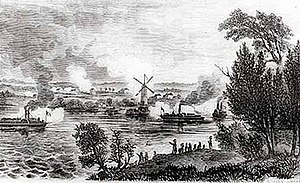| Patriot War | |||||||
|---|---|---|---|---|---|---|---|
| Part of the Rebellions of 1837–1838 | |||||||
 Battle of the Windmill, Prescott | |||||||
| |||||||
| Belligerents | |||||||
|
|
Hunters' Lodge | ||||||
| Commanders and leaders | |||||||
|
|
Robert Nelson Cyrille-Hector-Octave Côté Charles Duncombe William Lyon Mackenzie Nils von Schoultz Donald McLeod | ||||||
| Casualties and losses | |||||||
|
30 killed 86 wounded |
Hunters' Lodge: 92 killed 81 wounded 222–243 captured Republic of Canada: Entire force captured | ||||||
The Patriot War was a conflict along the Canada–United States border in which bands of raiders attacked the British colony of Upper Canada more than a dozen times between December 1837 and December 1838. This so-called war was not a conflict between nations; it was a war of ideas fought by like-minded people against British forces, with the British eventually allying with the US government against the Patriots.[1]
Participants in the conflict were members of a secret association known as the Hunter's Lodge, formed in the United States in sympathy with the 1837 Rebellions in Upper and Lower Canada. The organization arose in Vermont among Lower Canadian refugees (the eastern division or Frères chasseurs) and spread westward under the influence of Dr Charles Duncombe and Donald McLeod, leaders of the short-lived Canadian Refugee Relief Association, and Scotland native William Lyon Mackenzie, drawing support from several different locations in North America and Europe. The Republic of Canada was also short-lived. After a heavy bombardment by the British on Navy Island, where the republic had been established, Mackenzie and his force of Canadian militia retreated to Buffalo, New York, where they were captured by the U.S. Army. On charges of violating the neutrality between the United States and the British Empire, they were sentenced to 18 months imprisonment. This brought to an end what the British viewed as an inconsequential and unsupported colonial rebellion. The organizations were made up of grass-roots armed militants whose goal was to overthrow British rule in Canada. Their dispersal involved the largest deployment of U.S. troops against their own citizens since the Whiskey Rebellion of 1794.[2]
- ^ McLaughlin, Shaun J. (2013). The Patriot War Along the Michigan-Canada Border: Raiders and Rebels. Charleston, South Carolina: History Press. p. i. ISBN 978-1-62619-055-9.
- ^ Bonthius, Andrew (2003). "The Patriot War of 1837–1838: Locofocoism With a Gun?". Labour/Le Travail. 52: 10–11. doi:10.2307/25149383. JSTOR 25149383. S2CID 142863197.